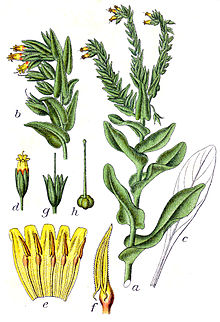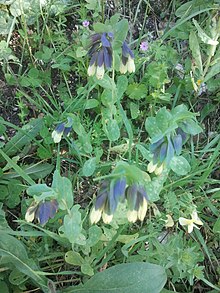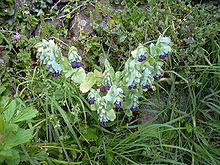Wax flowers (cerinthe)
| Wax flowers | ||||||||||||
|---|---|---|---|---|---|---|---|---|---|---|---|---|

Large wax flower ( Cerinthe major ) |
||||||||||||
| Systematics | ||||||||||||
|
||||||||||||
| Scientific name | ||||||||||||
| Cerinthe | ||||||||||||
| L. |
The plant genus of the wax flowers ( Cerinthe ) belongs to the family of the Raublatt- or Boragegewächse (Boraginaceae). The ten or so species are mainly found in the Mediterranean and Central Europe. Varieties of fewer species are used as ornamental plants .
description


Appearance and leaves
Cerinthe species grow as annual to perennial herbaceous plants . The vegetative parts of the plant are, unlike typical for the family, bare to almost bare. The alternate arranged on the stems leaves are simple and entire margin; they are often blue-green, with white warts in some species; in some species they are arrow-shaped around the stem.
Inflorescences and flowers
Several flowers stand together in terminal, zymous , often branched inflorescences . There are bracts available. The hermaphroditic flowers are radial symmetry and five-fold with a double flower envelope . The five free or fused sepals up to half their length are unequal and inserted at different heights. The five petals are fused to a cylindrical corolla tube over at least half of their length. The five corolla lobes are upright to curved back depending on the species. The petals are yellow and mostly, especially at their base, tinted purple to red; there are purple varieties. There are no scales on the petals (differentiation from closely related genera). The five stamens do not protrude above the corolla. The stamens are inserted halfway up the petals. The two carpels each have only two ovules . The stylus usually protrudes over the corolla and ends in a cephalic or edged stigma.
fruit
In contrast to the typical family with four partial fruits, the split fruit in this genus only breaks down into two partial fruits, each of which consists of two intergrown, single-seeded nuts . The two overgrown nuts are egg-shaped, dark-brown to black, smooth, with short beaks and flat at their base.
Sets of chromosomes
Depending on the section, the basic chromosome number is x = 8 or 9. Diploidy is present in all species, i.e. 2n = 16 or 2n = 18 depending on the section.
Systematics and distribution

The genus Cerinthe was established in 1753 by Carl von Linné . The lectotype species was Cerinthe major L. by Albert Spear Hitchcock in 1929 in Nomenclature: Proposals by British Botanists. London , p. 128. The genus Cerinthe belongs to the tribe Lithospermeae in the subfamily Boraginoideae within the family Boraginaceae .
The distribution area of the six to ten species extends from Central, Southern and Eastern Europe to North Africa and the Middle East. In Germany only the small wax flower and the alpine wax flower are native.
The genus Cerinthe is divided into two sections: Cerinthe sect. Cerinthe and Cerinthe sect. Ceranthe .
There are six to ten Cerinthe typologies:
-
Bald wax flower or Alpine wax flower ( Cerinthe glabra Mill. ): There are two subspecies:
- Cerinthe glabra Mill. Subsp. glabra (Syn .: Cerinthe alpina Schult. , Cerinthe pyrenaica Arv.-Tour. ): It is widespread in Central and Eastern Europe up to Turkey and the Caucasus.
- Cerinthe glabra subsp. smithiae (A.Kern.) Domac : It occurs only in Croatia .
-
Cerinthe gymnandra Gasp. Person : There are two subspecies:
- Cerinthe gymnandra Gasp. Person subsp. gymnandra : It is common in the western Mediterranean .
- Cerinthe gymnandra subsp. oranensis (Batt.) Valdés (Syn .: Cerinthe oranensis Batt. ): It occurs in Morocco, Algeria, Tunisia and Libya.
- Large wax flower ( Cerinthe major L. , Syn .: Cerinthe aspera Roth , Cerinthe major subsp. Purpurascens (Boiss.) Selvi & L.Cecchi , Cerinthe major var. Purpurascens Boiss. ): It is widespread in the Mediterranean region and in the Middle East.
-
Small wax flower ( Cerinthe minor L. , Syn .: Cerinthe indigotisans Borbás , Cerinthe longiflora Viv. ): There are three subspecies:
- Cerinthe minor L. subsp. minor : It is widespread in Central and Eastern Europe.
- Cerinthe minor subsp. auriculata (Ten.) Domac (Syn .: Cerinthe auriculata Ten. , Cerinthe maculata L. ): It thrives in the Alps , the Appennines , Sicily and the Balkan Peninsula .
- Cerinthe minor subsp. cleiostoma (Boiss. & Sprun.) Selvi & Cecchi (Syn .: Cerinthe cleiostoma Boiss. & Sprun. , Cerinthe lamprocarpa Murb. , Cerinthe tristis Teyber ): It occurs in Croatia, Bosnia-Herzegovina, Montenegro and Greece.
- Cerinthe palaestina Eig & Sam. : It occurs in Syria, Lebanon and Israel.
- Purple wax flower ( Cerinthe retorta Sm. ): It occurs in Croatia, Albania, Macedonia, Greece, Crete, in the Aegean Sea and in Turkey.
- Cerinthe tenuiflora Bertol. : She is endemic to Corsica .
use
Varieties of fewer species are used as ornamental plants in parks and gardens in temperate latitudes. Examples are bald wax flower ( Cerinthe glabra ) and large wax flower ( Cerinthe major ); of the latter there is, for example, the 'Purpurascens' variety. They are considered a pasture for bees .
swell
- Radovan Domac: Cerinthe. In: TG Tutin, VH Heywood, NA Burges, DM Moore, DH Valentine, SM Walters, DA Webb (eds.): Flora Europaea . Volume 3: Diapensiaceae to Myoporaceae . Cambridge University Press, Cambridge 1972, ISBN 0-521-08489-X , pp. 94–95 (English, limited preview in Google Book Search).
- Federico Selvi, Lorenzo Cecchi, Andrea Coppi: Phylogeny, karyotype evolution and taxonomy of Cerinthe L. (Boraginaceae). In: Taxon , Volume 58, Issue 4, 2009, pp. 1307-1325. JSTOR 27757019
Individual evidence
- ↑ a b c d e f g h i j k l m n Radovan Domac: Cerinthe. In: TG Tutin, VH Heywood, NA Burges, DM Moore, DH Valentine, SM Walters, DA Webb (eds.): Flora Europaea . Volume 3: Diapensiaceae to Myoporaceae . Cambridge University Press, Cambridge 1972, ISBN 0-521-08489-X , pp. 94–95 (English, limited preview in Google Book Search).
- ↑ a b c d e f g h i j Federico Selvi, Lorenzo Cecchi, Andrea Coppi: Phylogeny, karyotype evolution and taxonomy of Cerinthe L. (Boraginaceae). In: Taxon , Volume 58, Issue 4, 2009, pp. 1307-1325. JSTOR 27757019
- ^ Linnaeus scanned in at biodiversitylibrary.org in 1753 .
- ↑ Cerinthe at Tropicos.org. Missouri Botanical Garden, St. Louis, accessed on May 12, 2014.
- ^ A b c Cerinthe in the Germplasm Resources Information Network (GRIN), USDA , ARS , National Genetic Resources Program. National Germplasm Resources Laboratory, Beltsville, Maryland. Retrieved May 12, 2014.
- ↑ a b c d e f g h i B. Valdés, 2011: Boraginaceae. : Cerinthe In: Werner Greuter (Ed.): Euro + Med Plantbase - the information resource for Euro-Mediterranean plant diversity.
- ↑ Peter Schönfelder , Ingrid Schönfelder: The new cosmos Mediterranean flora. Franckh Kosmos Verlag Stuttgart 2008. ISBN 978-3-440-10742-3 . P. 138.
- ↑ Gordon Cheers (Ed.): Botanica. The ABC of plants. 10,000 species in text and images . Könemann Verlagsgesellschaft, 2003, ISBN 3-8331-1600-5 (therein page 213).
Web links
- Thomas Meyer, Michael Hassler: Mediterranean and Alpine flora. [1]


